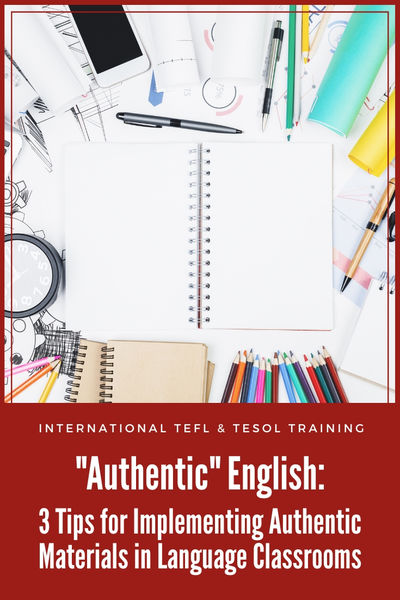"Authentic" English: 3 Tips for Implementing Authentic Materials in Language Classrooms

Authentic materials are media that native speakers of a language encounter in their everyday lives, which are not specifically created for language students. TV programs, newspaper articles, books, songs, YouTube videos, and more all fall under this term.
Table of Contents
1. Take advantage of pre-teaching.
2. Focus on a single language point and give your students a clear goal.
3. Vary the role authentic materials play in your lessons.
Are you ready to teach English as a foreign language?
Incorporating authentic materials into ESL classrooms has numerous merits, but the high language level required to understand these materials often causes teachers to rarely or never include them in classes below an intermediate language level. However, the difficulty of language in authentic materials does not necessarily mean that they have no place in lower-level classes. With some research, planning, and creativity, any teacher can expose their students to authentic materials. Here are three strategies that can help with the lesson planning process.
1. Take advantage of pre-teaching.
Authentic materials often use language that is not commonly taught in classrooms. This makes them excellent supplements for existing lessons in your curricula. For example, if one of your lessons covers food and restaurant vocabulary, consider bringing a real menu to class. Students can exercise their new skills through this material while also learning new terms they might not otherwise encounter.
Additionally, supplementing lessons with authentic materials in this way opens numerous opportunities to tie cultural education into lessons. Perhaps students could compare menus of various countries or learn about regional delicacies around the world.
Take note of the language that students learn through your curricula and the unknown language authentic materials could potentially teach. This will help in choosing the right material for your lessons.
2. Focus on a single language point and give your students a clear goal.
Even if the language of a certain material is difficult, you can create an activity that suits your students' language level. The key is to identify individual language points and focus on only one of them in a lesson.
For example, imagine you want to use store coupons in class. Each coupon contains several language points such as dates, conditionals, adjectives, and contact information. Take note of each specific point and design an activity around a point your students know or could easily learn. In a class for beginners, you might make a listening activity focusing on the coupons' phone numbers or email addresses. Elementary level students, on the other hand, might respond well to a reading comprehension activity based on the adjectives found in the coupons.
The language contained in authentic materials is intimidating as a whole. However, guiding your students towards one specific part of the material reminds them that they hold enough prior knowledge to understand something. Reminders such as this are powerful in the face of difficult material.

3. Vary the role authentic materials play in your lessons.
You do not have to put authentic materials at the center of a lesson. They can be just as effective as warm-up or closing activities.
One such activity that works well with authentic materials is making predictions. To start, show students a portion of material -- the first minute of a video, the opening seconds of a song, et cetera. Then ask students to speak or write their predictions for what will happen next. You can adapt this activity as an opening that segues into your lesson's main topic, or as a closing that allows students to practice whatever language points, they have just studied.
Visual authentic materials work especially well for short activities such as this because various clues outside of language communicate meaning. Keep this in mind and experiment with how authentic materials fit into your lesson plan.
Are you ready to teach English as a foreign language?
Finding authentic materials that fit your class's needs may be difficult. However, authentic materials offer many benefits that created materials do not.
Classroom English and coursebook English often sounds too controlled, and authentic materials demonstrate current, naturally-spoken English. Authentic materials also have the potential to introduce diverse dialects, which rarely appear in coursebooks.
Students can gain confidence knowing that they can understand a material meant for native speakers. Moreover, teaching students strategies for navigating difficult material will serve them well as they continue their language studies.
No matter your students' skill level, it is possible to introduce them to the world of authentic materials. Seize the opportunities to use them as they come.
Apply now & get certified to teach english abroad!
Speak with an ITTT advisor today to put together your personal plan for teaching English abroad.
Send us an email or call us toll-free at 1-800-490-0531 to speak with an ITTT advisor today.
Related Articles:
- How do I get a job teaching English in South Korea
- 10 Questions You Need to Ask Before Enrolling In a TEFL Course
- The 10 Best Destinations for Teaching English Abroad in 2018
- Online or In-Class - Which TEFL Course Should You Take?
- The Best Government Programs For Teaching English Abroad
- What Scams to Look Out for When Looking for TEFL Jobs




